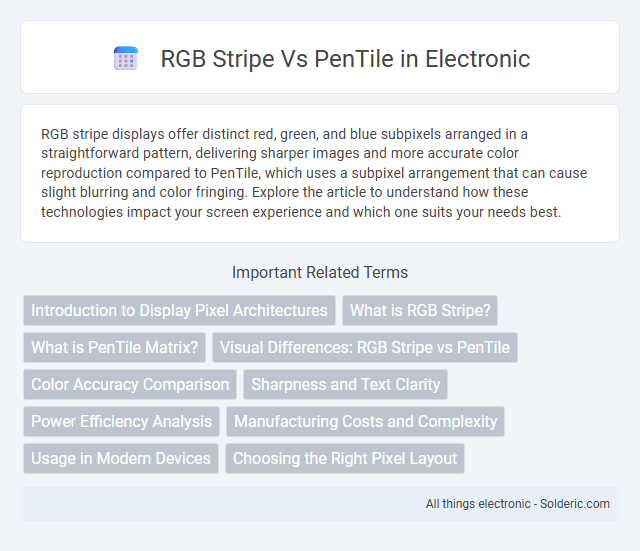RGB stripe displays offer distinct red, green, and blue subpixels arranged in a straightforward pattern, delivering sharper images and more accurate color reproduction compared to PenTile, which uses a subpixel arrangement that can cause slight blurring and color fringing. Explore the article to understand how these technologies impact your screen experience and which one suits your needs best.
Comparison Table
| Feature | RGB Stripe | PenTile |
|---|---|---|
| Subpixel Arrangement | Red, Green, Blue arranged in repeating stripes | Alternating pixel layout with shared subpixels (e.g., RG, GB) |
| Image Sharpness | Higher sharpness due to full RGB per pixel | Potentially lower sharpness, especially on text |
| Power Efficiency | Standard power consumption | Better power efficiency by reducing subpixel count |
| Manufacturing Cost | Higher due to precise RGB subpixels | Lower with fewer subpixels and simpler design |
| Display Brightness | Generally brighter displays | Brightness may be lower due to fewer subpixels |
| Use Cases | High-end displays, TVs, monitors | Smartphones, wearable devices, energy-conscious screens |
Introduction to Display Pixel Architectures
RGB stripe and PenTile are two distinct display pixel architectures impacting screen clarity and color accuracy. The RGB stripe arranges red, green, and blue subpixels in a linear sequence, offering consistent color reproduction and sharp image quality ideal for detailed visuals. PenTile uses a subpixel layout that varies in color distribution, which can improve energy efficiency and extend display lifespan but may result in less precise color rendering compared to the RGB stripe.
What is RGB Stripe?
RGB Stripe is a subpixel arrangement used in displays where each pixel consists of three distinct, evenly sized subpixels in red, green, and blue colors. This layout ensures uniform subpixel distribution, resulting in sharper text rendering and more accurate color reproduction compared to PenTile technology. The consistent subpixel pattern in RGB Stripe enhances image clarity, especially in high-resolution displays.
What is PenTile Matrix?
PenTile Matrix is a subpixel arrangement used in OLED and some LCD displays that differs from traditional RGB stripe layouts by sharing subpixels between neighboring pixels. This design reduces power consumption and extends display lifespan while maintaining perceived resolution through pixel rendering algorithms. Your experience may include slightly softer text or images compared to the sharpness offered by conventional RGB stripe panels, especially at lower resolutions.
Visual Differences: RGB Stripe vs PenTile
RGB Stripe displays use a red, green, and blue subpixel arrangement in a straight, repeating pattern, resulting in sharper and more consistent image clarity. PenTile technology employs a diamond-shaped subpixel layout with fewer subpixels per pixel, which can cause reduced sharpness and visible color fringing, especially in text and fine details. Understanding these visual differences helps you choose a display that best matches your need for crisp, vibrant images or power-efficient technology.
Color Accuracy Comparison
The RGB stripe display delivers superior color accuracy by utilizing three subpixels per pixel--red, green, and blue--resulting in precise color reproduction and sharper image quality. PenTile displays, while more power-efficient, use shared subpixels which can cause color fringing and less accurate color rendering, especially noticeable in text and fine details. Overall, RGB stripe technology provides more consistent and vibrant colors for applications requiring high fidelity and crisp visuals.
Sharpness and Text Clarity
RGB stripe displays use a full triad of red, green, and blue subpixels for each pixel, resulting in higher sharpness and superior text clarity due to uniform subpixel arrangement. PenTile technology employs a subpixel layout with fewer subpixels per pixel, often leading to reduced sharpness and slightly blurred text rendering, especially at lower resolutions. Consequently, RGB stripe panels are preferable for applications demanding crisp text and fine detail visibility.
Power Efficiency Analysis
RGB stripe displays have a straightforward pixel structure that can lead to more consistent power consumption, making them generally more power-efficient for bright, high-contrast images. PenTile technology reduces power usage by using fewer subpixels and relying on shared subpixels between pixels, which can significantly lower power consumption in lower brightness settings, ideal for typical daily use. You should consider your usage pattern, as RGB stripe might consume more power during high brightness scenarios, while PenTile excels in energy savings during moderate to low brightness.
Manufacturing Costs and Complexity
RGB stripe displays generally have higher manufacturing complexity due to the precise alignment of red, green, and blue subpixels in a fixed pattern, increasing production costs. PenTile technology reduces manufacturing costs by using fewer subpixels and sharing them between pixels, simplifying the layout and saving materials. Your choice between these display types may impact device pricing and production efficiency, given their differing cost structures.
Usage in Modern Devices
RGB stripe technology is widely used in modern LCD and OLED displays, offering precise subpixel arrangement that enhances color accuracy and sharpness in smartphones, tablets, and monitors. PenTile matrices are common in AMOLED screens, especially in high-end smartphones and VR headsets, providing power efficiency and extended display lifespan despite occasionally sacrificing some sharpness in text and fine details. Manufacturers often choose RGB stripe for devices prioritizing visual clarity, while PenTile is favored for energy-saving benefits in portable and wearable gadgets.
Choosing the Right Pixel Layout
Choosing the right pixel layout depends on display clarity and color accuracy, where RGB stripe offers a direct arrangement of red, green, and blue subpixels delivering sharper images and more consistent colors. PenTile, using fewer subpixels per pixel, trades off some sharpness and color fidelity for power efficiency and longer OLED panel lifespan. For applications requiring high-resolution text and images, RGB stripe is preferred, while PenTile suits devices prioritizing battery life and display longevity.
RGB stripe vs PenTile Infographic

 solderic.com
solderic.com